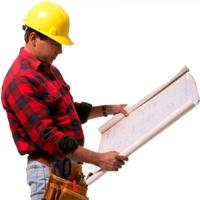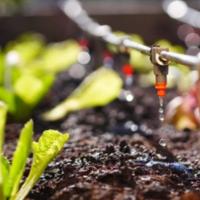A Simple Guideline to Drip Irrigation Installation
by Guest on Feb 25, 2016
It is estimated that less than 21% of the earth's surface is filled with fresh water. These statistics show that water is becoming a more scarce resource as the days go by and hence the need to conserve it by all means. The amount of water used in watering our gardens can be reduced by drip irrigation installation that also ensures that every drop of it is utilized. This article provides a simple guide that will make your work easier in the efforts of reducing water wastage and keeping your garden green.
How to Install Garden Irrigation System
To answer the question, of how to install a garden irrigation system, you must have the correct irrigation supplies. A good drip irrigation kit will comprise a hammer, Hunter irrigation controllers, timer, various emitters, hose-plug, and connectors half/quarter-inch tubing and terminals, shears, 12-volt water pump, hole punch, and clamps.
Before you initialize setting up your drip irrigation system, you need to have a proper plan for your garden. This plan will be determined by the size of the backyard as well as the type of crops in it. Plants have different water requirements and therefore they will require different supplies. It is advisable to set up different zones for different plants to make your irrigation easier.
Drip Irrigation Installation Steps
- i. The first step involves measuring the area to be irrigated. If you had already planted before installation, then you need to take the measurement of the individual rows and measure the distance from the central water faucet.
- ii. Draw a sketch of the garden with the accepted measures and counter-check it with the actual layout on the ground. It becomes easier to work with a drawn plan than with the trial and error method.
- iii. After you have your measurements, then you need to establish the layout that your system will take. Here, there are two available options; the first option is to run the main faucet at the edge of the field from which you connect sub-lines across the rows. The main challenge with this layout is the possibility of increased leaking due to the numerous connections. It is, however, suitable for large fields' irrigation. The second option includes twisting the tubing around each row up to the end of the field. There are no instances of leakage in this setup, but it is only convenient for small gardens.
- iv. Connect the tubing using connectors and secure them firmly to the ground.
- v. Make holes in the irrigation lines behind the plant being watered. Water regulators can be used to control the amount of water each plant receives per hour.
- vi. When the ground is set, and then connects the main water line to the setup system of regulators and timer.
- vii. Turn on the faucet manually or with a timer to check your system for leakages and other malfunctions. There are several on a water pump to regulate pressure to the desired level.
Popular Articles
Three Places to Spend Money on the Exterior of Your Home
When you have the exterior of your home remodeled, you are investing, time, energy and convenience into the project and you want to make sure that...
104917 Views
Homemade Headboards-Make an Upholstered or Wooden Headboard
Homemade headboards can add a lot of personality to any bedroom. They can be coordinated with existing furniture and room decor or they can be the...
80138 Views
When to Use a Brush, Roller or Sponge Brush
Brushes are a good choice for painting trim and woodwork. They are also useful for cutting in the edges around the top and bottom edges and corners...
72814 Views
Creating a Cottage Kitchen with Bead Board
Kitchen decor can range from modern and bold to elegant and elaborate by using strategic kitchen pieces. One of the most popular decorating trends...
58567 Views
Gas Fireplace Diagnostics and Troubleshooting
Follow these steps for diagnosing and troubleshooting Gas Fireplaces repairs. For the average DIYer, this may seem intimidating, depending on the...
35604 Views
Latest Articles
How Much Does it Cost to Take a Bath?
Plumbers know that a bath may seem like a relaxing luxury, but the real cost extends far beyond your water bill. The average soak uses 35 to 50...
on Apr 8, 2025
10 Concrete Patio Ideas on a Budget
A concrete patio can be a game-changer for your outdoor space. It is durable, versatile, and can be customized to fit your style. But what if you...
on Mar 25, 2025
Tips for Creating a Stunning Personalized Photo on Canvas
Order the unique beauty of a personalized photo on canvas and bring your memories to life. With a customized photo on canvas, you can transform...
on Mar 7, 2025
Best Areas to Buy Property in Singapore for Long-Term Growth
Singapore's real estate market remains one of the most stable and lucrative in the world. With limited land supply, strong governmental...
on Feb 18, 2025
Troubleshooting Excess Water in Your HVAC Secondary Condensate Drain Pan
When maintaining your air conditioning system, it is easy to overlook the condensate drain pan - until excess water starts pooling in places where...
on Jan 12, 2025
Featured Articles
What Type of Licensed Contractor Should You Hire?
on Feb 28, 2017
Hire Contractors / Estimates

Looking for a specialty project? There are many types of contractors available for your home improvement needs. Finding the right type of...
Sponsored Articles
Best Areas to Buy Property in Singapore for Long-Term Growth
on Feb 18, 2025
Real Estate / Finance

Singapore's real estate market remains one of the most stable and lucrative in the world. With limited land supply, strong governmental...
Actions
Top Categories
- Garden / Landscaping / Patio — 264
- Kitchen / Bathrooms — 240
- Real Estate / Finance — 203
- Appliance / Repair — 186
- Interior Design / Decor — 184
- HVAC / Air Conditioning — 148
- Cleaning / Maintenance — 144
- Improvements / Remodeling — 131
- Plumbing / Basements — 118
- Floors / Tile / Hardwood — 116
- Doors / Garages — 113
- Safety / Security — 113
Articles Archive
More DIY Articles
How to Choose the Right Plunge Cut Saw
Plunge cut saws are a must-have for any serious carpenter. When a project calls for cutting a straight line, pairing a quality plunge cut saw with...
Swimming Pools: Buying a Swimming Pool
Buying a swimming pool can be quite a difficult decision indeed, especially when you are trying to decide between an in ground pool or an above...
The Lifespan of Exterior House Painting and What Affects It
The lifespan of an exterior house painting could vary on many different factors. A long one is important for the full functionality of the painting...
Lawn Irrigation
Homeowners have a choice of two different types of sprinkler-heads when deciding what is best for their yard. The spray and rotor head can both be...
How to Select the Right Electrical Contractor
Selecting the right electrical contractor isn't as easy as picking someone out of the Yellow Pages. The ramifications of hiring the wrong...

